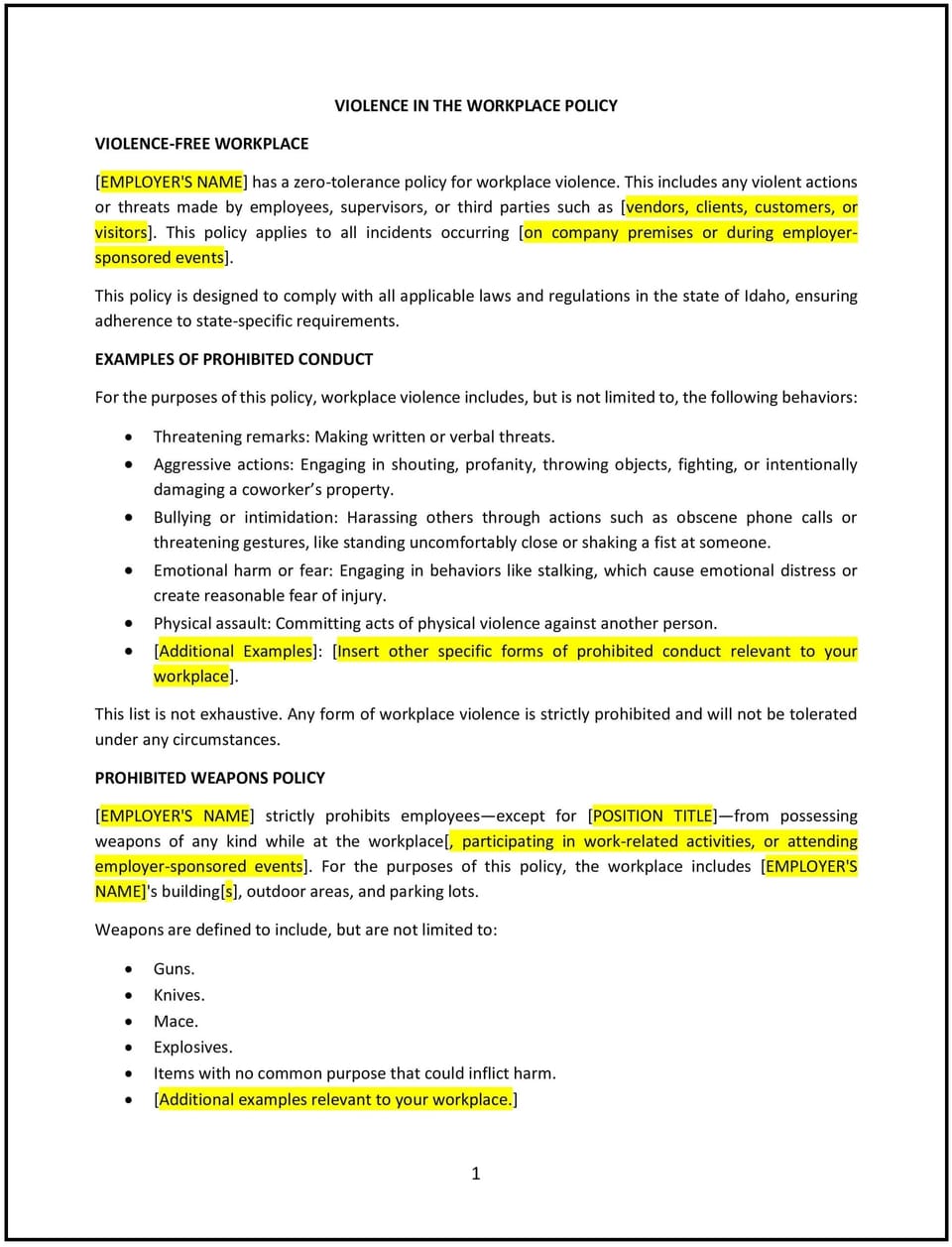Violence in the workplace policy (Idaho): Free template

Violence in the workplace policy (Idaho)
A violence in the workplace policy helps Idaho businesses establish guidelines for preventing and addressing violent behavior, threats, or harassment in the workplace. This policy outlines prohibited behaviors, reporting procedures, and steps for responding to incidents. It also emphasizes the importance of maintaining a safe and respectful work environment for all employees.
By implementing this policy, businesses can protect employees, reduce risks, and foster a culture of safety and accountability.
How to use this violence in the workplace policy (Idaho)
- Define prohibited behaviors: Specify the types of behaviors considered violent or threatening, such as physical violence, verbal threats, harassment, or intimidation, to ensure clarity and consistency in applying the policy.
- Establish reporting procedures: Provide clear instructions for employees to report incidents of violence or threats, including multiple reporting channels and protections against retaliation.
- Develop response protocols: Outline the steps for responding to incidents, such as investigating reports, providing support to affected employees, and taking disciplinary action when necessary.
- Address prevention measures: Include guidelines for preventing workplace violence, such as conducting background checks, providing conflict resolution training, and maintaining a secure work environment.
- Train employees: Provide training for employees on how to recognize and report violent behavior, follow the policy’s procedures, and maintain a safe workplace.
- Train managers: Equip managers with the skills to address violent incidents, enforce the policy consistently, and support employees who report violence or threats.
- Review and update the policy: Periodically assess the policy’s effectiveness and make adjustments based on changes in business needs, employee feedback, or Idaho laws.
Benefits of using this violence in the workplace policy (Idaho)
This policy offers several advantages for Idaho businesses:
- Protects employee safety: Clear guidelines help prevent and address violent behavior, creating a safer work environment for all employees.
- Reduces risks: The policy minimizes the risk of workplace violence, legal disputes, or reputational damage caused by violent incidents.
- Enhances workplace morale: A safe and respectful workplace fosters trust, engagement, and productivity among employees.
- Supports compliance: The policy helps businesses adhere to best practices for workplace safety and reduce the risk of legal penalties.
- Encourages accountability: Clear expectations and consequences help employees understand their responsibilities and the importance of adhering to the policy.
- Fosters a culture of safety: The policy reinforces the business’s commitment to maintaining a safe and respectful workplace.
Tips for using this violence in the workplace policy (Idaho)
- Communicate the policy clearly: Share the policy with employees during onboarding and through internal communication channels to ensure awareness and understanding.
- Train employees: Provide training on how to recognize and report violent behavior, follow the policy’s procedures, and maintain a safe workplace.
- Train managers: Equip managers with the skills to address violent incidents, enforce the policy consistently, and support employees who report violence or threats.
- Monitor compliance: Regularly review workplace behavior and address any potential issues promptly to ensure adherence to the policy.
- Encourage transparency: Foster a culture where employees feel comfortable reporting violent behavior or threats without fear of retaliation.
- Document everything: Maintain records of policy communications, training sessions, and any actions taken to enforce the policy, ensuring accountability and transparency.
Q: Why should Idaho businesses have a violence in the workplace policy?
A: A violence in the workplace policy provides clear guidelines for preventing and addressing violent behavior, protecting employee safety, and fostering a respectful work environment.
Q: What types of behaviors should businesses address in the policy?
A: Businesses should address behaviors such as physical violence, verbal threats, harassment, intimidation, and any other actions that create a hostile work environment.
Q: How should employees report incidents of workplace violence?
A: Employees should follow the reporting procedures outlined in the policy, which may include multiple channels, such as reporting to a manager, HR, or an anonymous hotline.
Q: What steps should businesses take to respond to violent incidents?
A: Businesses should investigate reports promptly, provide support to affected employees, and take appropriate disciplinary action, as outlined in the policy.
Q: How can businesses prevent workplace violence?
A: Businesses should implement prevention measures, such as conducting background checks, providing conflict resolution training, and maintaining a secure work environment.
Q: What training should employees receive on workplace violence?
A: Employees should receive training on how to recognize and report violent behavior, follow the policy’s procedures, and maintain a safe workplace.
Q: How often should businesses review their violence in the workplace policy?
A: Businesses should review the policy annually or as needed to ensure it aligns with current business needs, employee feedback, or Idaho laws.
This article contains general legal information and does not contain legal advice. Cobrief is not a law firm or a substitute for an attorney or law firm. The law is complex and changes often. For legal advice, please ask a lawyer.


